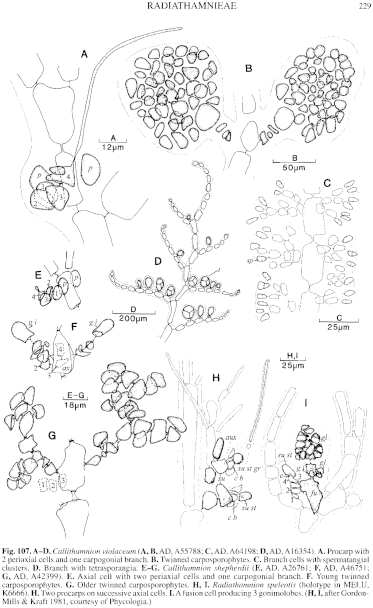|
|
|
|
|
|||||||||||
|
Electronic Flora of South Australia Species Fact Sheet
Phylum Rhodophyta – Order Ceramiales – Family Ceramiaceae – Tribe Callithamnieae
Thallus (Fig. 114A, B) erect, flaccid and spreading, red-brown, 2–5 (–10) cm high, profusely branched with corticate upper and mid thallus grading from slender, ultimate, irregular branches (not flat-topped) to lower corticated axes. Attachment by rhizoids from base of axes; epilithic or epiphytic. Structure. Apical cells with rounded ends (pointed ends on some lower lateral branchlets) without terminal hairs, 2.5–5 (–6.5) µm in diameter and L/D (3–) 4–10 (–12), subapical cells 4–8 µm in diameter and L/D 4–8, increasing gradually (Fig. 114E, G) to mid thallus cells 10–25 (–60) µm in diameter and L/D 4–6 (–12), with broad sheaths, then to lower cells 200–450 µm in diameter (contents 35–60 µm in diameter) and L/D 1–2, with down-growing rhizoids developing within the broad gelatinous sheaths, from the basal cells of laterals and from the axial cells, and forming a complete cortical layer (Fig. 114C); rhizoids (3–) 5–12 µm in diameter, cells long. Cells uninucleate; rhodoplasts elongate, ribbon like in larger cells.
Reproduction: Gametophytes dioecious. Procarps borne on axial cells of lesser branches, with 2 periaxial cells, one becoming a 4-celled carpogonial branch (Fig. 107E). Post-fertilization each produces an auxiliary cell (Fig. 107E) which develops gonimolobes (Fig. 107G, 114D) developing into irregularly rounded lobes (Fig. 114E) 80–300 across of ovoid carposporangia 10–20 µm in diameter; no involucre occurs. Spermatangia (Fig. 114F) borne on short branched filaments or clusters, often in series on successive cells.
Tetrasporangia (Fig. 114G, H) sessile on upper branchlets, ovoid to sub-spherical, 25–35 µm in diameter, tetrahedrally to more or less decussately divided.
Holotype from American R. inlet, Kangaroo I., S., Aust., 2–3 m deep in channel (Kraft, 7.iv.1972; AD, A42399).
Selected specimens: Off Waldegrave I., S. Aust., on Osmundaria, 22 m deep (Shepherd, 23.x.1970; AD, A37413) and 21 m deep (Shepherd, 30.x.1983: AD, A54504). 6–8 km off Outer Harbor, S. Aust., 16 m deep (Loan, 9.viii.1963; AD, A26658). Port Noarlunga, S. Aust., 5 m deep, in cave entrance on shore side of reef (Thomas, 16.xii.1975; AD, A46751). American R. inlet, Kangaroo I., S. Aust., drift (Womersley, 25.viii.1963: AD, A26745).
Distribution: Waldegrave I. to Port Noarlunga and American R. inlet, Kangaroo I., S. Australia.
Taxonomic notes: The species is named after Dr Scoresby Shepherd, who has contributed greatly to knowledge of our subtidal algae by his SCUBA diving activities.
C. shepherdii is based on a female type specimen with tetrasporangial specimens known from the same locality. Male and tetrasporangial specimens are known from Waldegrave I., corresponding well in all vegetative features.
C. shepherdii is close to C. caulescens in most features, differing in the latter having multinucleate cells.
References: The Marine Benthic Flora of Southern Australia Part IIIC
Publication:
Womersley, H.B.S. (24 December, 1998)
The Marine Benthic Flora of Southern Australia
Rhodophyta. Part IIIC. Ceramiales – Ceramiaceae, Dasyaceae
©State Herbarium of South Australia, Government of South Australia
Illustrations in Womersley Part IIIA, 1998: FIGS 107 E–C, 114.

Figure 107 enlarge
Fig. 107. A–D. Callithamnion violaceum (A, B, AD, A55788; C, AD, A64198; D, AD, A16354). A. Procarp with 2 periaxial cells and one carpogonial branch. B. Twinned carposporophytes. C. Branch cells with spermatangial clusters. D. Branch with tetrasporangia. E–G. Callithamnion shepherdii (E, AD, A26761; F, AD, A46751; G, AD, A42399). E. Axial cell with two periaxial cells and one carpogonial branch. F. Young twinned carposporophytes. G. Older twinned carposporophytes. H, I. Radiathamnion speleotis (holotype in MELU, K6666). H. Two procarps on successive axial cells. I. A fusion cell producing 3 gonimolobes. (H, I, after Gordon-Mills & Kraft 1981, courtesy of Phycologia.)

Figure 114 enlarge
Fig. 114. Callithamnion shepherdii (A, C, E, AD, A42399; B, G, H, AD, A54504; D, AD, A46751; F, AD. A37413). A. Habit, type. B. Habit of plant on Osmundaria. C. Cortication of lower axis. D. Twinned young carposporophytes. E. Thallus with 4 twinned carposporophytes. F. Branches with spermatangial clusters. G. Branches with tetrasporangia. H. Tetrasporangia on branchlets.

|
Email Contact: State Herbarium of South Australia |

|